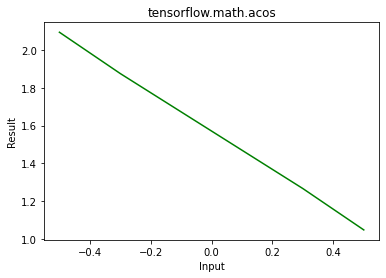TensorFlow es una biblioteca de Python de código abierto diseñada por Google para desarrollar modelos de aprendizaje automático y redes neuronales de aprendizaje profundo.
acos() se usa para encontrar elementos sabios acos de x.
Sintaxis: tf.math.acos(x, nombre)
Parámetros:
- x: Es el tensor de entrada. Los dtype permitidos para este tensor son bfloat16, half, float32, float64.
- name(opcional): Define el nombre de la operación.
Devoluciones: Devuelve un tensor del mismo tipo que x.
Ejemplo 1:
Python3
# Importing the library
import tensorflow as tf
# Initializing the input tensor
a = tf.constant([ -.5, -.3, 0, .3, .5], dtype = tf.float64)
# Printing the input tensor
print('Input: ', a)
# Calculating tangent
res = tf.math.acos(x = a)
# Printing the result
print('Result: ', res)
Producción:
Input: tf.Tensor([-0.5 -0.3 0. 0.3 0.5], shape=(5, ), dtype=float64) Result: tf.Tensor([2.0943951 1.87548898 1.57079633 1.26610367 1.04719755], shape=(5, ), dtype=float64)
Ejemplo 2: Visualización
Python3
# Importing the library
import tensorflow as tf
import matplotlib.pyplot as plt
# Initializing the input tensor
a = tf.constant([-.5, -.3, 0, .3, .5], dtype = tf.float64)
# Calculating tangent
res = tf.math.acos(x = a)
# Plotting the graph
plt.plot(a, res, color ='green')
plt.title('tensorflow.math.acos')
plt.xlabel('Input')
plt.ylabel('Result')
plt.show()
Producción:

Publicación traducida automáticamente
Artículo escrito por aman neekhara y traducido por Barcelona Geeks. The original can be accessed here. Licence: CCBY-SA